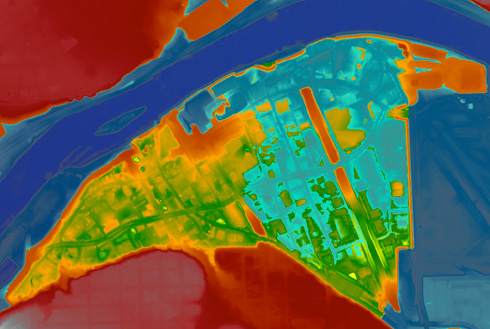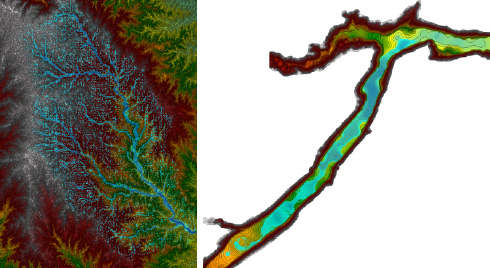Featured Projects — Software HEC-RAS2D
The Hydrologic Engineering Center’s River Analysis System (HEC-RAS) is a software product used to perform free-surface hydraulic calculations for overland flow. Historically, HEC-RAS was born as a product for 1D networks of open channels and rivers. In 2011, HEC asked RMA to develop an extension of HEC-RAS for 2D flow. Since then, RMA has been the developer behind the 2D computational engine, a fundamental part of HEC-RAS starting with version 4.2 (2014).
RMA has implemented two theoretical models for solution of 2D flow:
- Shallow Water Equations Solver, which disregards vertical velocities and assumes hydrostatic pressure
- Diffusive Wave Approximation Solver, which additionally omits unsteady, advection and turbulent viscous terms, providing a model with a narrower range of applicability but many computational advantages
The RAS2D solvers developed by RMA have multiple features that distinguish them from comparable software products
- Application to a wide variety of computational grids independently of their structure and orthogonality properties
- Bathymetric information and geometric aspects that allow coarser grids and improve computation speed
- Effortless application of various boundary conditions and seamless integration into the 1D HEC-RAS software
- Stable and efficient treatment of wetting and drying
- Fully multi-threaded execution easily controlled by the user
Results and benefits
The 2D computational flow solver within HEC-RAS is the primary tool to perform free-surface hydrodynamic analysis for dam breaks, levee breaches, and flood scenarios. Our scientific software development has expanded the range of applicability of HEC-RAS and solidified its position as one of the main products for hydraulic simulation.

Urban levee breach simulation (Saint Paul, MN).

Left: Rainfall simulation for watershed overland routing. Right: Flood wave propagation down a river valley following a dam failure.